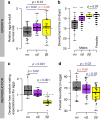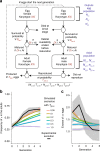Balancing selection via life-history trade-offs maintains an inversion polymorphism in a seaweed fly
- PMID: 32015341
- PMCID: PMC6997199
- DOI: 10.1038/s41467-020-14479-7
Balancing selection via life-history trade-offs maintains an inversion polymorphism in a seaweed fly
Abstract
How natural diversity is maintained is an evolutionary puzzle. Genetic variation can be eroded by drift and directional selection but some polymorphisms persist for long time periods, implicating a role for balancing selection. Here, we investigate the maintenance of a chromosomal inversion polymorphism in the seaweed fly Coelopa frigida. Using experimental evolution and quantifying fitness, we show that the inversion underlies a life-history trade-off, whereby each haplotype has opposing effects on larval survival and adult reproduction. Numerical simulations confirm that such antagonistic pleiotropy can maintain polymorphism. Our results also highlight the importance of sex-specific effects, dominance and environmental heterogeneity, whose interaction enhances the maintenance of polymorphism through antagonistic pleiotropy. Overall, our findings directly demonstrate how overdominance and sexual antagonism can emerge from a life-history trade-off, inviting reconsideration of antagonistic pleiotropy as a key part of multi-headed balancing selection processes that enable the persistence of genetic variation.
Conflict of interest statement
The authors declare no competing interests.
Figures





Similar articles
-
Antagonistic pleiotropy in species with separate sexes, and the maintenance of genetic variation in life-history traits and fitness.Evolution. 2018 Jun;72(6):1306-1316. doi: 10.1111/evo.13493. Epub 2018 May 5. Evolution. 2018. PMID: 29667189
-
The potential of inversions to accumulate balanced sexual antagonism is supported by simulations and Drosophila experiments.Elife. 2025 Apr 16;12:RP93338. doi: 10.7554/eLife.93338. Elife. 2025. PMID: 40237307 Free PMC article.
-
A general population genetic framework for antagonistic selection that accounts for demography and recurrent mutation.Genetics. 2012 Apr;190(4):1477-89. doi: 10.1534/genetics.111.137117. Epub 2012 Jan 31. Genetics. 2012. PMID: 22298707 Free PMC article.
-
Eco-Evolutionary Genomics of Chromosomal Inversions.Trends Ecol Evol. 2018 Jun;33(6):427-440. doi: 10.1016/j.tree.2018.04.002. Epub 2018 May 3. Trends Ecol Evol. 2018. PMID: 29731154 Review.
-
Dominance reversals: the resolution of genetic conflict and maintenance of genetic variation.Proc Biol Sci. 2024 Mar 13;291(2018):20232816. doi: 10.1098/rspb.2023.2816. Epub 2024 Mar 13. Proc Biol Sci. 2024. PMID: 38471544 Free PMC article. Review.
Cited by
-
From the woods to the halls of science: Louis Bernatchez's contributions to science, wildlife conservation and people.Evol Appl. 2020 Jul 14;13(6):1105-1116. doi: 10.1111/eva.13043. eCollection 2020 Jul. Evol Appl. 2020. PMID: 32684949 Free PMC article. No abstract available.
-
Polymorphism in the aggressive mimicry lure of the parasitic freshwater mussel Lampsilis fasciola.PeerJ. 2024 May 24;12:e17359. doi: 10.7717/peerj.17359. eCollection 2024. PeerJ. 2024. PMID: 38803583 Free PMC article.
-
A supergene in seaweed flies modulates male traits and female perception.Proc Biol Sci. 2023 Oct 11;290(2008):20231494. doi: 10.1098/rspb.2023.1494. Epub 2023 Oct 11. Proc Biol Sci. 2023. PMID: 37817592 Free PMC article.
-
The Effect of an Irradiation-Induced Recombination Suppressing Inversion on the Genetic Stability and Biological Quality of a White Eye-Based Aedes aegypti Genetic Sexing Strain.Insects. 2022 Oct 18;13(10):946. doi: 10.3390/insects13100946. Insects. 2022. PMID: 36292893 Free PMC article.
-
6Pgdh polymorphism in wild bulb mite populations: prevalence, environmental correlates and life history trade-offs.Exp Appl Acarol. 2024 Jun;93(1):115-132. doi: 10.1007/s10493-024-00909-4. Epub 2024 Apr 10. Exp Appl Acarol. 2024. PMID: 38597987 Free PMC article.
References
-
- Brian, Charlesworth & Hugues, K. A. The maintenance of genetic variation in life-history traits. In Evolutionary Genetics from Molecules to Morphology (eds Singh, R. S. & Krimbas, C. B.) 369–392 (Cambridge University Press, Cambridge, 2000).
-
- Prout, Timothy. How well does opposing selection maintain variation? In Evolutionary Genetics From Molecules to Morphology (eds Singh, R. S. & Krimbas, C. B.) 157–181 (Cambridge University Press, Cambridge, 2000).
Publication types
MeSH terms
LinkOut - more resources
Full Text Sources

